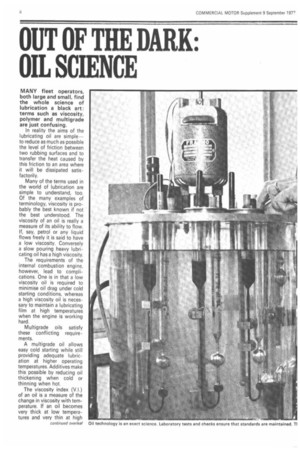OUT OF THE DARK: OIL SCIENCE
Page 50

Page 52

If you've noticed an error in this article please click here to report it so we can fix it.
MANY fleet operators, both large and small, find the whole science of lubrication a black art: terms such as viscosity, polymer and multigrade are just confusing.
In reality the aims of the lubricating oil are simple to reduce as much as possible the level of friction between two rubbing surfaces and to transfer the heat caused by this friction to an area where it will be dissipated satisfactorily.
Many of the terms used in the world of lubrication are simple to understand, too. Of the many examples of terminology, viscosity is probably the best known if not the best understood. The viscosity of an oil is really a measure of its ability to flow. If, say, petrol or any liquid flows freely it is said to have a low viscosity. Conversely a slow pouring heavy lubricating oil has a high viscosity.
The requirements of the internal combustion engine, however, lead to complications. One is in that a low viscosity oil is required to minimise oil drag under cold starting conditions, whereas a high viscosity oil is necessary to maintain a lubricating film at high temperatures when the engine is working hard.
Multigrade oils satisfy these conflicting requirements.
A multigrade oil allows easy cold starting while still providing adequate lubrication at higher operating temperatures. Additives make this possible by reducing oil thickening when cold or thinning when hot.
The viscosity index (V.I.) of an oil is a measure of the change in viscosity with temperature. If an oil becomes very thick at low temperatures and very thin at high temperatures, it is said to have a low viscosity index or V.I.
If there is comparatively little change in viscosity with temperature, then the oil is said to have a high viscosity index. If a graph is plotted of viscosity against ternperature, then a relatively flat curve is indicative of a high quality oil which will satisfy the conflicting requirements of both high and low temperature work.
The ideal, of course, would -be an oil which retained its viscosity regardless of temperature, but so far no such oil exists.
A classification system which has gained worldwide acceptance is that of the Society of Automotive Engineers. The oils are classified solely on the basis of viscosity which is where the terminology SAE 20, SAE 40, etc, comes from. It is important to realise that the SAE number merely tells you the viscosity at one temperature—it does not give any indication as to the additives contained in the oil or whether it is low or high V.I.
Under the general heading of oil "additives" comes the detergent or dispersant as it is known occasionally. These detergents reduce sludge formation in the engine's lubrication system by keeping dirt particles in suspension in the oil. These solid particles are inevitable in an engine because of soot from the combustion process.
Although the soot originally forms in minute particles, these particles tend to stick together and in extreme cases can block the oilways. The oil, therefore, must keep these minute particles in suspension so that they can still flow at least as far as the oil filter.
These additives are usually complex materials which have a metallic base. A simple analogy is common salt— sodium chloride.
You eat the salt so you are effectively eating a metallic compound. The additives in oil have a similar metallic content although the compound as a whole is infinitely more complex than table salt.
One unwanted characteristic of the additive is that it forms an oxide when burnt so you end up with an ash. If you burn a plain undoctored mineral oil, there is no ash, but with the added metallic compound a residue of some sort is always left. Because of this the engine manufacturers always put a maximum limit on the ash content for any particular lubricating oil used in their engines.
In addition to these two primary additives, there are other advanced additives and inhibitors present in commercial vehicle engine lubricants. These perform various functions and include:
Anti-oxidant
The natural resistance of mineral oils to oxidation needs fortification by the presence, in controlled quantities, of suitable anti-oxidants in order to prevent oil degradation under prolonged high-temperature service conditions in the presence of air.
Anti-wear
Apart from their primary function as oxidation in hibitors, some additives also exhibit wear-reducing properties, as for example zinc dithiophosphate. It is therefore often useful to employ this type of additive because of its ability to increase load carrying properties of the lubricating oil.
Anti-foam
While the function is self explanatory, this inhibiting agent is included in modern engine lubricants to keep foaming down to a low level, in all conditions of usage. Another consideration is the influence of fuel dilution on oil foaming tendencies.
Corrosion inhibition
Condensation is a permanent hazard of the internal combustion engine operating cycle, particularly through its alliance with blow-by gases and highly acidic combustion products. The prevention of internal rusting when the engine is standing idle is a further aspect of corrosion inhibition.
These additives are carefully selected to ensure that an engine lubricant complies with the most rigorous standards.
• by the Technical Editor
















































































































